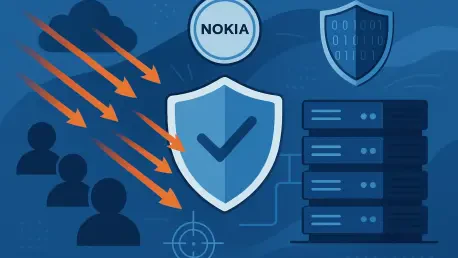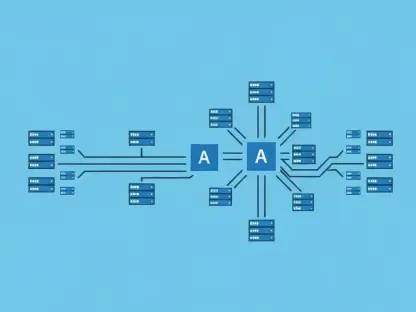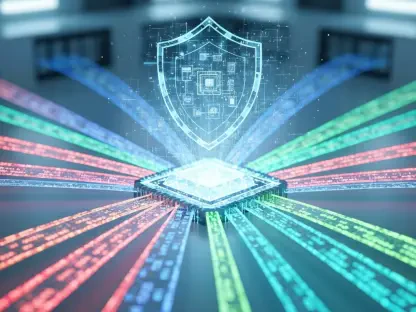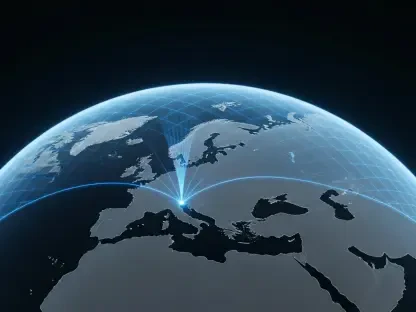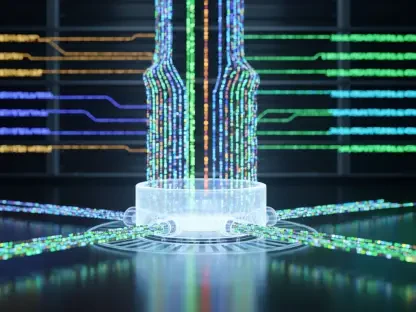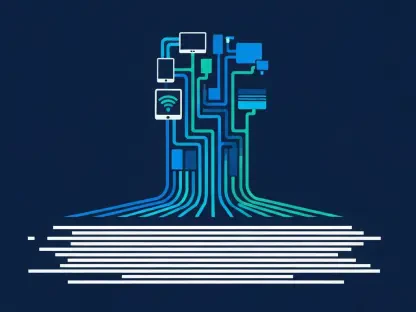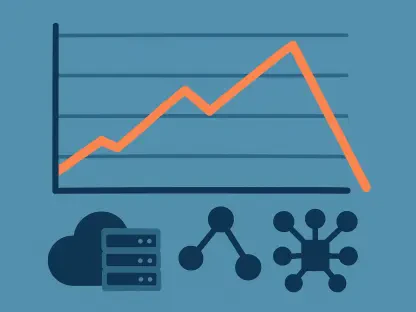In an era where digital connectivity underpins nearly every aspect of business and daily life, the threat of Distributed Denial of Service (DDoS) attacks looms larger than ever, capable of grinding entire networks to a halt with devastating financial and operational consequences. These malicious assaults flood systems with illegitimate traffic, overwhelming infrastructure and disrupting critical services for carriers, internet exchanges, and enterprises alike. Nokia, a prominent name in network technology, has introduced a potentially transformative solution through its Deepfield Defender software paired with the high-performance FP5 network processor, claiming it can neutralize DDoS attacks in real-time. As cyber threats grow in both frequency and sophistication, the need for robust, immediate defenses becomes paramount. This article delves into the mechanics of Nokia’s innovative approach, examines a high-profile live test that showcased its capabilities, and considers the broader implications for network security in a hyper-connected world.
Unpacking the Technology Powering Nokia’s Solution
The cornerstone of Nokia’s defense against DDoS attacks lies in the synergy between its FP5 network processor and the Deepfield Defender software, a combination engineered to tackle malicious traffic with unprecedented speed and precision. The FP5 chip is designed for high-capacity networks, capable of processing vast data volumes while managing extensive access control list entries directly in hardware. This allows for granular filtering of IP traffic at line rate, ensuring that harmful packets are blocked without introducing delays. Meanwhile, Deepfield Defender leverages artificial intelligence to analyze network telemetry, identifying attack patterns through sampled data and deploying dynamic filters instantly. This integration means that legitimate traffic continues to flow smoothly, sidestepping the latency issues that often hinder traditional mitigation methods. By addressing threats directly at the network ingress, this technology offers a streamlined approach that could redefine how operators protect their infrastructure.
Beyond the hardware’s raw power, the AI-driven capabilities of Deepfield Defender bring a layer of adaptability that is critical in today’s fast-evolving threat landscape. Drawing from a constantly updated resource known as Deepfield Secure Genome®, the software maintains a comprehensive “security map of the internet,” enabling it to detect emerging dangers like new botnets or attack variants. This proactive stance eliminates the reliance on manual intervention, which has long been a bottleneck in conventional security protocols. Automation ensures that responses are not only swift but also tailored to the specific nature of each threat, minimizing the risk of overblocking or service disruptions. For network operators dealing with ever-increasing traffic loads, this level of precision and efficiency represents a significant advancement, potentially reducing the operational overhead associated with managing cyber defenses while maintaining robust protection against sophisticated DDoS campaigns.
Testing the Limits: A Live Demonstration at NL-ix
To validate the effectiveness of its technology, Nokia conducted a live test at NL-ix, Europe’s largest distributed internet exchange, which handles peak traffic capacities of up to 50 Tbps. This real-world environment provided a rigorous proving ground, as the test involved a production network carrying legitimate VPN traffic under the strain of a simulated DDoS attack. Network architects crafted a complex assault by randomizing packet fields to mimic the unpredictable nature of real malicious traffic, challenging the system to distinguish between harmful and benign data flows. The objective was straightforward yet critical: could the solution detect and mitigate the threat without impacting normal operations? This high-stakes demonstration offered a glimpse into how Nokia’s tools perform under pressure, providing valuable insights into their practical applicability for carriers and exchanges facing constant cyber risks in their day-to-day operations.
The results of the NL-ix test were striking, showcasing the real-time responsiveness of Deepfield Defender in a live setting. Within mere seconds of the attack’s onset, the software identified the anomaly and deployed hundreds of targeted filters to block malicious packets at the point of entry. Legitimate traffic continued without interruption, while harmful data was effectively dropped before it could reach downstream customers. Once the threat subsided, the system automatically removed the filters, demonstrating a seamless cycle of detection, mitigation, and recovery. This rapid, automated response, underpinned by the FP5 processor’s hardware acceleration, highlighted the potential for such technology to maintain network integrity even during intense DDoS events. The success of this trial in a production environment underscores the viability of Nokia’s approach as a reliable defense mechanism for large-scale networks.
Implications for the Future of Network Security
One of the most compelling aspects of Nokia’s solution is its scalability and ease of integration, making it a feasible option for diverse network environments. Capable of supporting customer ports up to 800 Gbps, the technology has proven its reliability over nearly three years of production use, including rigorous testing in controlled scenarios. Deployment requires minimal infrastructure—just a pair of on-premise servers for Deepfield Defender—allowing it to blend seamlessly with existing Nokia FP5-based routing systems. This practicality is crucial for large-scale internet exchanges and carriers that manage enormous traffic volumes daily while facing persistent cyber threats. By reducing the complexity of implementation, Nokia’s approach lowers the barrier to adopting advanced DDoS mitigation, potentially enabling a wider range of operators to bolster their defenses without overhauling their current setups.
Looking ahead, the success at NL-ix points to a broader shift in how DDoS defense is approached, moving toward inline mitigation that stops attacks at the source rather than relying on traffic rerouting or external scrubbing centers. Combining the raw speed of specialized hardware with the adaptive intelligence of AI-driven software, Nokia’s technology offers a model for reducing operational burdens while enhancing protection. As DDoS attacks become more intricate, solutions like Deepfield Defender could set a new benchmark for network security, equipping operators with tools to stay ahead of threats. The implications extend beyond immediate defense, suggesting a future where automated, scalable systems become the norm, reshaping how critical infrastructure is safeguarded in an increasingly digital landscape. This advancement prompts consideration of how industry standards might evolve to prioritize real-time, integrated solutions over outdated, reactive measures.
